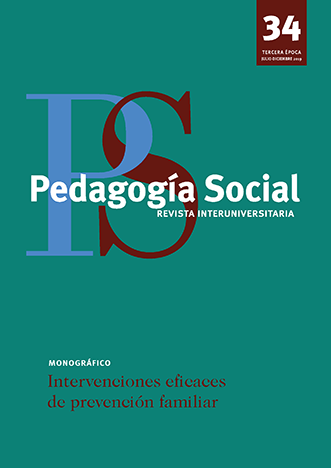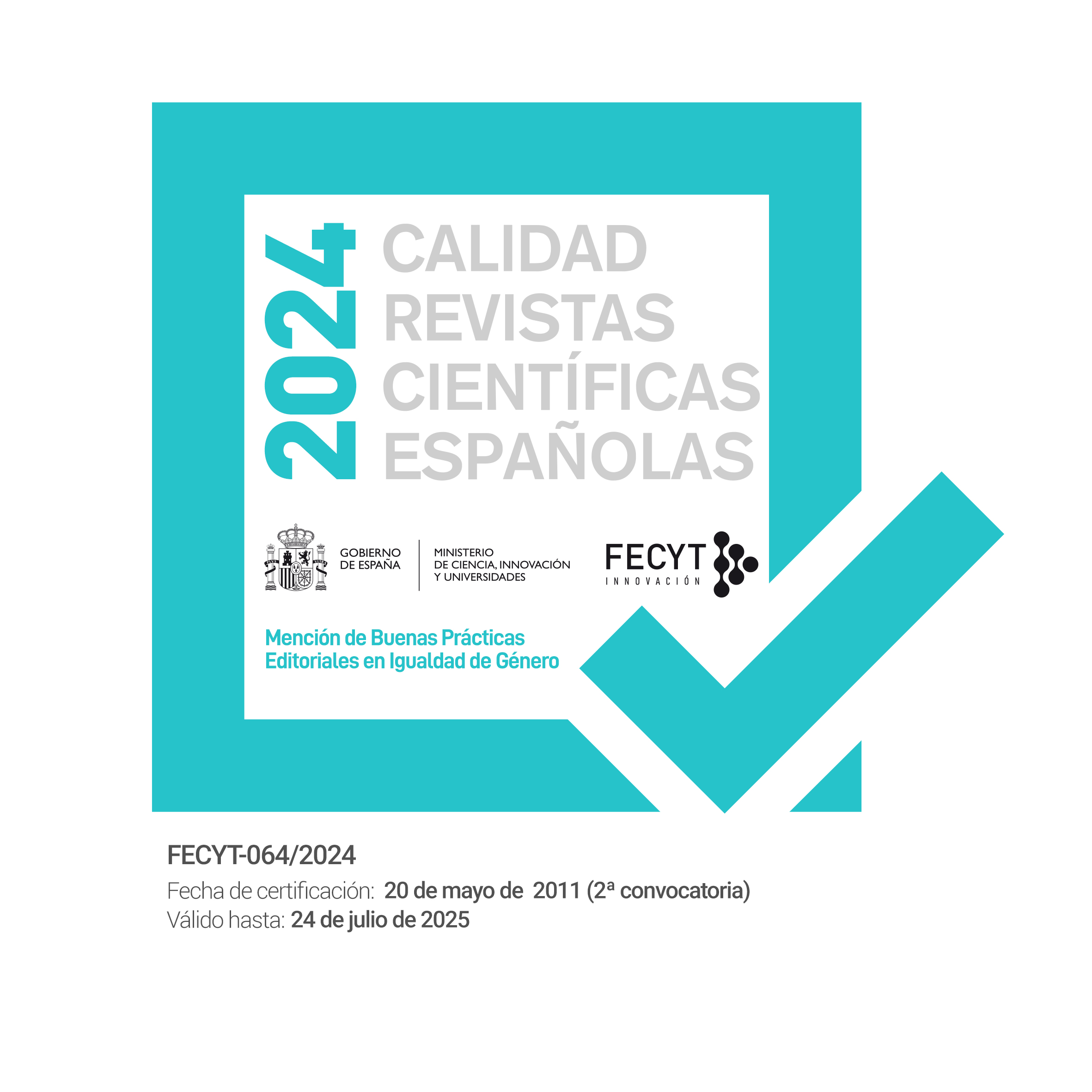Una revisión sistemática de la participación en los programas de prevención familiar
DOI:
https://doi.org/10.7179/PSRI_2019.34.05Palabras clave:
Participación, retención, implicación parental, prevención, programas familiares.Resumen
Una de las principales razones del fracaso de las intervenciones familiares está relacionada con baja participación y retención de las familias. Las dificultades para promover participación y retención adecuadas es uno de los obstáculos más importantes en la implementación y diseminación de las intervenciones familiares basadas en la evidencia. Aunque en la literatura se describe una amplia gama de estrategias para involucrar a los padres, se sabe poco sobre qué estrategias son más efectivas para mejorar la participación. Por ello, se ha llevado a cabo una revisión sistemática de factores predictivos de la participación de los padres y las estrategias de mejora en los programas parentales de prevención. Los criterios de inclusión fueron: 1) estudios basados en evidencias con componente de intervención familiar, revisiones teóricas y empíricas de la literatura, y revisiones sistemáticas; 2) artículos publicados en Portugués, Inglés y Español; 3) publicados entre 2000 y 2018. Se encontraron 39 artículos que informaron sobre una variedad de factores predictivos de la participación familiar y métodos efectivos para involucrar a las familias en actividades preventivas. Surgieron cuatro dimensiones básicas: 1) predictores de participación; 2) características asociadas al programa; 3) obstáculos para la participación; 4) estrategias para minimizar las barreras de participación. Se identificaron cuatro grupos distintos de predictores de participación: patrones de interacción familiar; cogniciones y atribuciones de los padres sobre los problemas de conducta del niño; variables psicológicas relacionadas con los padres; percepción parental de la intervención. Varios atributos intrínsecos y extrínsecos de la intervención se asociaron con la participación en programas familiares. Algunos obstáculos para la participación incluían problemas o circunstancias logísticas del entorno social de la familia. Las estrategias para minimizar las barreras incluyeron el uso de diferentes incentivos extrínsecos, el rol del capacitador y el ajuste de las expectativas y motivaciones de los padres durante la intervención.
Descargas
Citas
*Aalborg, A, Miller, B., Husson, G., Byrnes, H. Bauman, K., & Spoth, R. (2010). Implementation of adolescent family-based substance use prevention programmes in health care settings: Comparisions across conditions and programmes. Health Education Journal, 71(1), 53-61. doi:10.1177/0017896910386209
*Axford, N., Lehtonen, M., Kaoukji, D., Tobin, K., & Berry, V. (2012). Engaging parents in parenting programs: Lessons from research and practice. Children and Youth Services Review, 34(10), 2061-2071. doi:10.1016/j.childyouth.2012.06.011
*Baker C. N., Arnold D. H., & Meagher S. (2011). Enrollment and attendance in a parent training prevention program for conduct problems. Prevention Science, 12(2), 126–138. doi:10.1007/s11121-010-0187-0
Barrera, M., Berkel, C., & Castro, F. G. (2016). Directions for the advancement of culturally adapted preventive interventions: Local adaptations, engagement and sustainability. Prevention Science, 18(6), 640-648. doi:10.1007/s11121-016-0705-9
Becker, K. D., Lee, B. R., Daleiden, E. L., Lindsey, M., Brandt, N. E., & Chorpita, B. F. (2015). The common elements of engagement in children’s mental health services: Which elements for which outcomes? Journal of Clinical Child & Adolescent Psychology, 44(1), 30–43. doi:10.1080/15374416.2013.814543
*Byrnes, H. F., Miller, B. A., Aalborg, A. E., & Keagy, C. D. (2012). The relationship between neighborhood characteristics and recruitment into adolescent family-based substance use prevention programs. The Journal of Behavioral Health Services & Research, 39(2) 174-189. doi:10.1007/s11414-011-9260-0
*Bloomquist, M. L., August, G. J., Lee, S. S., Piehler, T. F., & Jensen, M. (2012). Parent Participation within community center or in-home outreach delivery models of the early risers conduct problems prevention program. Journal of Child and Family Studies, 21(3), 368-383. doi:10.1007/s10826-011-9488-6
Carman, k. L., Dardess, P., Maurer, M., Sofaer, S., Adams, K., Bechtel, C., & Sweeney, J. (2013). Patient and family engagement: A framework for understanding the elements and developing interventions and policies. Health Affairs, 32(2), 223-231. doi:10.1377/hlthaff.2012.1133
*Chacko, A., Jensen, S. A., Lowry, L. S., Cornwell, M., Chimklis, A., Chan, E., … Pulgarin, B. (2016). Engagement in behavioral parent training: Review of the literature and implications for practice. Clinical Child and Family Psychology Review, 19(3), 204–215. doi:10.1007/s10567-016-0205-2
*Chacko, A., Wymbs, B. T., Chimiklis, A., Wymbs, F. A., & Pelham, W. E. (2012). Evaluating a comprehensive strategy to improve engagement to group-based behavioral parent training for high-risk families of children with ADHA. Journal of Abnormal Child Psychology, 40(8), 1351-1362. doi:10.1007/s10802-012-9666-z
*Chacko, A., Wymbs, B. T., Wymbs, F. A., Pelham, W. E., Swanger-Gagne, M. S. S., Girio, E., & O’Connor, B. (2009). Enhancing traditional behavioral parent training for single mothers of children with ADHD. Journal of Clinical Child & Adolescent Psychology, 38(2), 206–218. doi:10.1080/15374410802698388
Coatsworth, J. D., Duncan, L. G., Pantin, H., & Szapocznik, J. (2006). Differential predictors of African American and Hispanic parent retention in a family-focused preventive intervention. Family Relations, 55(2), 240-251. doi:10.1111/j.1741-3729.2006.00373.x
*Coatsworth, J. D., Hemady, K. T., & George, M. W. (2018). Predictors of group leaders’ perceptions of parents’ initial and dynamic engagement in a family preventive intervention. Prevention Science, 19(5), 609-619. doi:10.1007/s11121-017-0781-5
*Connell, A. M., Dishion, T. J., Yasui, M., & Kavanagh, K. (2007). An adaptive approach to family intervention: linking engagement in family-centered intervention to reductions in adolescent problem behavior. Journal of Consulting and Clinical Psychology, 75(4), 568-579. doi:10.1037/0022-006X.75.4.568
*Eisner, M., & Meidert, U. (2011). Stages of parental engagement in a universal parent training program. Journal of Primary Prevention, 32(2), 83-93. doi:10.1007/s10935-011-0238-8
*Finan, S. J., Swierzbiolek, B, Priest, N., Warren, N., & Yap, M. (2018). Parental engagement in preventive parenting programs for child mental health: a systematic review of predictors and strategies to increase engagement. Peer J. 6:e4676; doi:10.7717/peerj.4676
*Garvey, C., Julion, W., Fogg, L., Kratovil, A., & Gross, D. (2006). Measuring participation in a prevention trial with parents of young children. Research in Nursing & Health, 29(3), 212-222. doi:10.1002/nur.20127
*Gonzalez, C., Morawska, A., & Haslam, D. M. (2018). Enhancing initial parental engagement in interventions for parents of young children: A systematic review of experimental studies. Clinical Child and Family Psychology Review, 21(3), 415-432. doi: 10.1007/s10567-018-0259-4
Gross, D., Julion, W., & Fogg, L. (2001). What motivates participation and dropout among low-income urban families of color in a prevention intervention? Family Relations, 50(3), 246–254. doi:10.1111/j.1741-3729.2001.00246.x
Haine-Schlagel, R., & Walsh, N. E. (2015). A Review of parent participation engagement in child and family mental health treatment. Clinical Child and Family Psychology Review., 18(2), 133–150. doi:10.1007/s10567-015-0182-x
*Heinrichs, N. (2006). The effects of two different incentives on recruitment rates of families into a prevention program. Journal of Primary Prevention 27(4), 345–365. doi:10.1007/s10935-006-0038-8
Heinrichs, N., Bertram, H., Kuschel, A., & Hahlweg, K. (2005). Parent recruitment and retention in a universal prevention program for child behavior and emotional problems: Barriers to research and program participation. Prevention Science, 6(4), 275-286. doi:10.1007/s11121-005-0006-1
*Ingoldsby, E. M. (2010). Review of interventions to improve family engagement and retention in parent and child mental health programs. Journal of Child and Family Studies, 19(5), 629–645. doi:10.1007/s10826-009-9350-2
*Kaminski, J. W., Valle, L. A., Filene, J. H., & Boyle, C. L. (2008). A meta-analytic review of components associated with parent training program effectiveness. Journal of Abnormal Child Psychology, 36(4), 567-589. doi: 10.1007/s10802-007-9201-9
*Kumpfer, K. L., & Johnson, J. L. (2007). Strengthening family interventions for the prevention of substance abuse in children of addicted parents. [Intervenciones de fortalecimiento familiar para la prevención del consumo de sustancias en hijos de padres adictos]. Adicciones, 19(1), 13-25. doi:10.20882/adicciones.320
*Mauricio, A. M., Tein, J. Y., Gonzales, N. A., Millsap, R. E., Dumka, L. E., & Berkel, C. (2014). Participation patterns among Mexican-American parents enrolled in a universal intervention and their association with child externalizing outcomes. American Journal of Community Psychology, 54(3-4), 370-383. doi:10.1007/s10464-014-9680-0.
*McCurdy, K., & Daro, D. (2001). Parent involvement in family support programs: An integrated theory. Family Relations, 50(2), 113–12. doi:10.1111/j.1741-3729.2001.00113.x
*McCurdy, K., Daro, D., Anisfeld, E., Katzev, A., Keim, A., LeCroy, C., … Winje, C. (2006). Understanding maternal intentions to engage in home visiting programs. Children and Youth Services Review, 28(10), 1195–1212. doi:10.1016/j.childyouth.2005.11.010
*Mian, N. D., Eisenhower, A. S., & Carter, A. S. (2015). Targeted prevention of childhood anxiety: engaging parents in an underserved community. American Journal of Community Psychology 55(1-2), 58-69 doi:10.1007/s10464-014-9696-5
*Miller, G. E., & Prinz, R. J. (2003). Engagement of families in treatment for childhood conduct problems. Behavior Therapy, 34(4), 517-534. doi:10.1016/s0005-7894(03)80033-3
*Morawska, A., & Sanders, M. R. (2006). A review of parental engagement in parenting interventions and strategies to promote it. Journal of Children’s Services, 1(1), 29–40. doi:10.1108/17466 66020 06000 04
Nix, R. L., Bierman, K. L., & McMahon, R. J. (2009). How attendance and quality of participation affect treatment response to parent management training. Journal of Consulting and Clinical Psychology, 77(3), 429-438. doi:10.1037/a0015028
*Negreiros, J. (2013). A participação dos pais na prevenção. Do uso de substâncias de base familiar intervenções: Uma análise empírica. SIPS - pedagogia social. Revista interuniversitária, 21, 39-65. Retrieved from http://www.redalyc.org/articulo.oa?id=135029517003
Nock, M. K., & Ferriter, C. (2005). Parent management of attendance and adherence in child and adolescent therapy: A conceptual and empirical review. Clinical Child and Family Psychology Review, 8(2),149–166. doi:10.1007/s10567-005-4753-0
*Nock, M. K., & Kazdin, A. E. (2005). Randomized controlled trial of a brief intervention for increasing participation in parent management training. Journal of Consulting and Clinical Psychology, 73(5), 872-879. doi:10.1037/0022-006X.73.5.872
Nordstrom, A. H., Dumas, J. E., & Gitter, A. H. (2008). Parental attributions and perceived intervention benefits and obstacles as predictors of maternal engagement in a preventive parenting program. NHSA Dialog 11(1), 1–24. doi: 10.1080/15240750701816439
*Orte, C., Ballester, L., Pascual, B., Antònia, M., & Amer, J. (2018). Las competencias de los formadores en el Programa de Competencia Familiar, un programa de educación familiar basado en la evidencia. Revista Complutense de Educación, 29(3), 651-663. doi:10.5209/RCED.53546
*Orte, C., Ballester, L., Amer, J., & Vives, M. (2014). Assessing the role of facilitators in evidence-based family prevention programs via Delphi technique. Families in Society, 95(4), 236–244. doi:10.1606/1044-3894.2014.95.30
*Orte, C., Ballester, L., Vives, M., & Amer, J. (2016). Quality of implementation in an evidence-based family prevention program: “The Family Competence Program”. Psychosocial Intervention, 25(2), 95–101. doi:10.1016/j.psi.2016.03.005
*Perrino, T., Coatsworth, J.D., Briones, E., Pantin, H., & Szapocznik, J. (2001). Initial engagement in parent-centered preventive interventions: A family systems perspective. Journal of Primary Prevention, 22(1), 21-44. doi:10.1023/a:1011036130341
*Perrino, T. Estrada, Y., Huang, S. George, S., Pantin, H. Cano, M. A., …, & Prado, G. (2018). Predictors of participation in a eHealth family-based preventive intervention for Hispanic youth. Prevention Science, 19(5), 630-641. doi: 0.1007/s11121-016-0711-y
*Prinz, R. J., Smith, E. P., Dumas, J. E., Laughlin, J. E., White, D. W., & Barrón, R. (2001). Recruitment and retention of participants in prevention trials involving family-based interventions. American Journal of Preventive Medicine, 20(1), 31-37. doi:10.1016/s0749-3797(00)00271-3
*Quinn, W. H., Hall, D. B., Smith, E. P., & Rabiner, D. (2010). Predictors of family participation in a multiple family group intervention for aggressive middle school students. Journal of Community Psychology, 38(2), 227-244. doi:10.1002/jcop.20361
*Rienks, S. L., Wadsworth, M. E., Markman, H. J., Einhorn, L., & Etter, E. M. (2011). Father involvement in urban low-income fathers: Baseline associations and changes resulting from preventive intervention. Family Relations, 60(2), 191-204. doi:10.1111/j.1741-3729.2010.00642.x
*Ross, A. M., & DeVoe, E. R. (2014). Engaging military parents in a home-based reintegration program: A consideration of strategies. Health & Social Work, 39(1), 47-54. doi:10.1093/hsw/hlu001
Ryan, S.M., Boxmeyer, C.L., & Lochman, J.E. (2009). Influence of risk factors for child disruptive behavior on parent attendance at a preventive intervention. Behavioral Disorders, 35(1), 41-52. doi:10.1177/019874290903500103
*Spoth, R. L., & Redmond, C. (2000). Research on family engagement in preventive interventions: Toward improved use of scientific findings in primary prevention practice. The Journal of Primary Prevention, 21(2), 267-284. doi: 10.1023/A:1007039421026.
*Sterrett, E., Jones, D. J., Zalot, A., & Shook, S. (2010). A pilot study of a brief motivational intervention to enhance parental engagement: A brief report. Journal of Child and Family Studies, 19(6), 697–701. doi:10.1007/s10826-010-9356-9
*Thompson, S. J., Bender, K., Lantry, J., & Flynn, P. M. (2007). Treatment engagement: Building therapeutic alliance in home-based treatment with adolescents and their families. Contemporary Family Therapy, 29(1-2), 39–55. doi:10.1007/s10591-007-9030-6
Valero, M., Ballester, L., Orte, C., & Amer, J. (2017). Meta-analysis of family-based selective prevention programs for drug consumption in adolescence. Psicotema, 29(3), 299-305. doi:10.7334/psicothema2016.275
*Winslow, E. B., Bonds, D., Wolchik, S., Sandler, I., & Braver, S. (2009). Predictors of enrollment and retention in a preventive parenting intervention for divorced families. Journal of Primary Prevention, 30(2), 151–172. doi:10.1007/s10935-009-0170-3
Descargas
Archivos adicionales
Publicado
Cómo citar
Número
Sección
Licencia
Derechos de autor 2019 Pedagogía Social. Revista Interuniversitaria

Esta obra está bajo una licencia internacional Creative Commons Atribución-NoComercial-CompartirIgual 4.0.
Derechos de reproducción y archivo
La versión publicada de los artículos podrá ser autoarchivada por sus autores en repositorios institucionales y temáticos de acceso abierto. No obstante la reutilización total o parcial de los mismos en nuevos trabajos o publicaciones deberá ser autorizada por Pedagogía Social. Revista Interuniversitaria.
Los trabajos publicados deberán ser citados incluyendo el título de la Revista, Pedagogía Social. Revista Interuniversitaria, nº, páginas y año de publicación.
Responsabilidades éticas
Pedagogía Social. Revista Interuniversitaria no acepta material publicado anteriormente en otros documentos. Los/as autores/as son responsables de obtener los permisos oportunos para reproducir parcialmente material de otras publicaciones y citar correctamente su procedencia. Estos permisos deben solicitarse tanto al autor/a como a la editorial que ha publicado dicho material.
Es obligación de Pedagogía Social. Revista Interuniversitaria detectar y denunciar prácticas fraudulentas.
En la lista de autores/as firmantes deben figurar únicamente aquellas personas que han contribuido intelectualmente al desarrollo del trabajo.
La revista espera que los/as autores/as declaren cualquier asociación comercial que pueda suponer un conflicto de intereses en conexión con el artículo remitido.
Los autores deben mencionar en el manuscrito, preferentemente en el apartado del método, que los procedimientos utilizados en los muestreos y controles han sido realizados tras la obtención de consentimiento informado.
La revista no utilizará ninguno de los trabajos recibidos con otro fin que no sea el de los objetivos descritos en estas normas.
Aviso de derechos de autor/a
© Pedagogía Social. Revista Interuniversitaria. Los originales publicados en las ediciones impresa y electrónica de esta Revista son propiedad del Pedagogía Social. Revista Interuniversitaria, siendo necesario citar la procedencia en cualquier reproducción parcial o total.
Salvo indicación contraria, todos los contenidos de la edición electrónica se distribuyen bajo una licencia de uso y distribución “Creative Commons Reconocimiento-No Comercial 3.0 España” (CC-by-nc). Puede consultar desde aquí la versión informativa y el texto legal de la licencia. Esta circunstancia ha de hacerse constar expresamente de esta forma cuando sea necesario.






